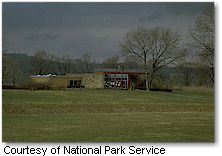|
 From about 200 BC to AD 500, the Ohio River Valley was a focal point of the prehistoric Hopewell culture. The term Hopewell describes a broad network of beliefs and practices among different Native American groups over a large portion of eastern North America. The culture is characterized by the construction of enclosures made of earthen walls, often built in geometric patterns, and mounds of various shapes. From about 200 BC to AD 500, the Ohio River Valley was a focal point of the prehistoric Hopewell culture. The term Hopewell describes a broad network of beliefs and practices among different Native American groups over a large portion of eastern North America. The culture is characterized by the construction of enclosures made of earthen walls, often built in geometric patterns, and mounds of various shapes.
Visible remnants of Hopewell culture are concentrated in the Scioto River valley near present-day Chillicothe, Ohio. The most striking Hopewell sites contain earthworks in the form of squares, circles, and other geometric shapes. Many of these sites were built to a monumental scale, with earthen walls up to 12 feet high outlining geometric figures more than
1,000 feet across. Conical and loaf-shaped earthen mounds up to 30 feet high are often found in association with the geometric earthworks.
The park contains nationally significant archeological resources including large earthwork and mound complexes that provide an insight into the social, ceremonial, political, and economic life of the Hopewell people.
Exhibits within the Hopewell Culture NHP Visitor Center display various artifacts recovered from the Mound City Group during previous excavations. Pottery, copper artifacts, and effigy pipes are just a few of the artifacts currently on display.
Self-guided and guided tours are also available.
Getting There:
Chillicothe is located in southcentral Ohio. The Mound City Group Visitor Center is located two miles north of the intersection of US 35 and SR 104.
|



